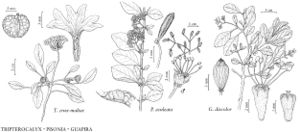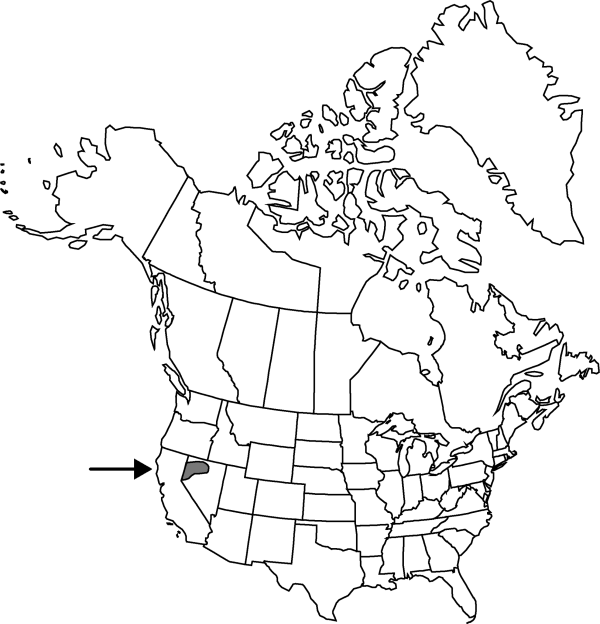Difference between revisions of "Tripterocalyx crux-maltae"
Contr. U.S. Natl. Herb. 12: 328. 1909.
IllustratedEndemic
Basionym: Abronia crux-maltae Kellogg Proc. Calif. Acad. Sci. 2: 71, fig. 16. 1863
FNA>Volume Importer |
imported>Volume Importer |
||
| (7 intermediate revisions by 2 users not shown) | |||
| Line 7: | Line 7: | ||
|year=1909 | |year=1909 | ||
}} | }} | ||
| − | |basionyms={{Treatment/ID/ | + | |special_status={{Treatment/ID/Special_status |
| + | |code=F | ||
| + | |label=Illustrated | ||
| + | }}{{Treatment/ID/Special_status | ||
| + | |code=E | ||
| + | |label=Endemic | ||
| + | }} | ||
| + | |basionyms={{Treatment/ID/Basionym | ||
|name=Abronia crux-maltae | |name=Abronia crux-maltae | ||
|authority=Kellogg | |authority=Kellogg | ||
| + | |rank=species | ||
| + | |publication_title=Proc. Calif. Acad. Sci. | ||
| + | |publication_place=2: 71, fig. 16. 1863 | ||
}} | }} | ||
|synonyms= | |synonyms= | ||
| Line 19: | Line 29: | ||
}}<!-- | }}<!-- | ||
| − | --><span class="statement" id="st- | + | --><span class="statement" id="st-undefined" data-properties=""><b>Stems </b>reddish, short glandular-pubescent, viscid. <b>Leaves</b>: petiole 1–4.5 cm; blade ovate to elliptic, 2.5–7 × 1–3 cm, margins entire to sinuate, sparsely short scabrous; surfaces glandular-pubescent, ± viscid, adaxial surface green or slightly glaucous. <b>Inflorescences</b> 10–30-flowered; bracts green, ovate to lanceolate, 3–12 × 1.5–3.5 mm, base attenuate, margins glandular short ciliate, viscid-pubescent. <b>Perianth</b>: tube greenish to pink, 8–25 mm, limb bright magenta, 10–15 mm diam., lobes well developed. <b>Fruits</b> oval to ± round in profile, 7–13 × 8–17 mm, walls indurate, transversely rugose or ribbed; lateral ribs prominent, extending into wings; wings 2(–3).</span><!-- |
-->{{Treatment/Body | -->{{Treatment/Body | ||
| + | |phenology=Flowering spring. | ||
|habitat=Sandy soils, sagebrush-scrub | |habitat=Sandy soils, sagebrush-scrub | ||
|elevation=1200-1500 m | |elevation=1200-1500 m | ||
| Line 33: | Line 44: | ||
-->{{#Taxon: | -->{{#Taxon: | ||
name=Tripterocalyx crux-maltae | name=Tripterocalyx crux-maltae | ||
| − | |||
|authority=(Kellogg) Standley | |authority=(Kellogg) Standley | ||
|rank=species | |rank=species | ||
| Line 40: | Line 50: | ||
|basionyms=Abronia crux-maltae | |basionyms=Abronia crux-maltae | ||
|family=Nyctaginaceae | |family=Nyctaginaceae | ||
| + | |phenology=Flowering spring. | ||
|habitat=Sandy soils, sagebrush-scrub | |habitat=Sandy soils, sagebrush-scrub | ||
|elevation=1200-1500 m | |elevation=1200-1500 m | ||
| Line 46: | Line 57: | ||
|publication title=Contr. U.S. Natl. Herb. | |publication title=Contr. U.S. Natl. Herb. | ||
|publication year=1909 | |publication year=1909 | ||
| − | |special status= | + | |special status=Illustrated;Endemic |
| − | |source xml=https:// | + | |source xml=https://bitbucket.org/aafc-mbb/fna-data-curation/src/2e0870ddd59836b60bcf96646a41e87ea5a5943a/coarse_grained_fna_xml/V4/V4_149.xml |
|genus=Tripterocalyx | |genus=Tripterocalyx | ||
|species=Tripterocalyx crux-maltae | |species=Tripterocalyx crux-maltae | ||
| − | |||
| − | |||
| − | |||
| − | |||
| − | |||
| − | |||
| − | |||
| − | |||
| − | |||
| − | |||
| − | |||
| − | |||
| − | |||
| − | |||
| − | |||
| − | |||
| − | |||
| − | |||
| − | |||
| − | |||
| − | |||
| − | |||
| − | |||
| − | |||
| − | |||
| − | |||
| − | |||
| − | |||
| − | |||
| − | |||
| − | |||
| − | |||
| − | |||
| − | |||
| − | |||
| − | |||
| − | |||
| − | |||
}}<!-- | }}<!-- | ||
-->[[Category:Treatment]][[Category:Tripterocalyx]] | -->[[Category:Treatment]][[Category:Tripterocalyx]] | ||
Latest revision as of 21:56, 5 November 2020
Stems reddish, short glandular-pubescent, viscid. Leaves: petiole 1–4.5 cm; blade ovate to elliptic, 2.5–7 × 1–3 cm, margins entire to sinuate, sparsely short scabrous; surfaces glandular-pubescent, ± viscid, adaxial surface green or slightly glaucous. Inflorescences 10–30-flowered; bracts green, ovate to lanceolate, 3–12 × 1.5–3.5 mm, base attenuate, margins glandular short ciliate, viscid-pubescent. Perianth: tube greenish to pink, 8–25 mm, limb bright magenta, 10–15 mm diam., lobes well developed. Fruits oval to ± round in profile, 7–13 × 8–17 mm, walls indurate, transversely rugose or ribbed; lateral ribs prominent, extending into wings; wings 2(–3).
Phenology: Flowering spring.
Habitat: Sandy soils, sagebrush-scrub
Elevation: 1200-1500 m
Discussion
Selected References
None.
Lower Taxa
None.

